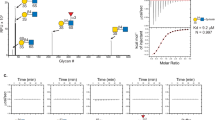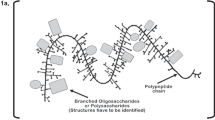Abstract
It has been reported that: (1) large variations were found in the number of sialic acid (SA) capped with N-acetyllactosamines (SA-Galβ1-4GlcNAc-R) and α-Gal epitopes (Galα1-3Galβ1-4GlcNAc-R) or uncapped N-acetyllactosamines (Galβ1-4GlcNAc-R) on different mammalian red blood cells, and on nucleated cells originating from a given tissue in various species; (2) goat, sheep, horse and mouse red blood cells lack α-Gal epitopes, despite the expression of this epitope on a variety of nucleated cells in these species, including lymphocytes differentiated from the same hematopoietic origin. In this study, flow cytometry and Western blot analyses of pig red blood cells showed that α-Gal epitopes on pig red cells developed concomitantly after treatment with neuraminidase, suggesting that the terminal N-acetyllactosaminide glycans were capped with SA-α-Gal epitopes. Whereas, the expression of the α-Gal epitopes on red blood cells from Sika deer (Cevus nippon hortulorum) were found to be absent even though the epitopes were present on their white blood cells. Thus, these results add new data not only for the terminal carbohydrate structures on cell surface glycans of various mammalian cells, but also for wide variety of epitope expression on the cells from different tissues, which might be useful for understanding their unique states resulting from differentiation and evolution.




Similar content being viewed by others
Abbreviations
- α-Gal:
-
Galα1-3Galβ1-4GlcNAc
- FACS:
-
Fluorescent activated cell sorting
- FCM:
-
Flow cytometry
- FITC:
-
Fluorescein isothiocyanate
- GlcNAc:
-
N-acetylglucosamine
- GS-IB4:
-
Griffonia simplicifolia isolectin B4
- hRBC-A and hRBC-O:
-
Group A and O of human red blood cell
- M86:
-
Mouse monoclonal antibody to α-gal epitopes
- NeuGc:
-
N-glycolylneuraminic acid
- N-acetyllactosamine:
-
Galβ1-4GlcNAc-R
- PBS:
-
Phosphate buffered saline
- PK15:
-
Pig kidney cell line
- PVDF:
-
Polyvinyidene fluoride
- SA:
-
Sialic acid
- TBST:
-
Tris-buffered saline, 0.1% Tween 20
References
Galili, U., Clark, M.R., Shohet, S.B., Buehler, J., Macher, B.A.: Evolutionary relationship between the anti-Gal antibody and the Galα1→3Gal epitope in primates. Proc. Natl. Acad. Sci. USA 84, 1369–1373 (1987)
Suzuki, N., Laskowski Jr., M., Lee, Y.C.: Phylogenetic expression of Galα1-4Gal on avian glycoproteins: Glycan differentiation inscribed in the early history of modern birds. Proc. Natl. Acad. Sci. USA 101, 9023–9028 (2004)
Suzuki, N., Laskowski Jr., M., Lee, Y.C.: Tracing the history of Galα1-4Gal on glycoproteins in modern birds. Biochim. Biophys. Acta 1760, 538–546 (2006)
Dennis, J.W., Granovsky, M., Warren, C.E.: Protein glycosylation in development and disease. BioEssays 21, 412–421 (1999)
Gagneux, P., Varki, A.: Evolutionary considerations in relating oligosaccharide diversity to biological function. Glycobiology 9, 747–755 (1999)
Hakomori, S.: Tumor-associated carbohydrate antigens defining tumor malignancy: basis for development of anti-cancer vaccines. Adv. Exp. Med. Biol. 491, 369–402 (2001)
Ezzelarab, M., Ayares, D., Cooper, D.K.C.: Carbohydrates in xenotransplantation. Immunol. Cell Biol. 83, 396–404 (2005)
Whiteheart, S.W., Hart, G.W.: Sialyltransferases as specific cell surface probes of terminal and penultimate saccharide structures on living cells. Anal. Biochem. 163, 123–135 (1987)
Ogawa, H., Galili, U.: Profiling terminal N-acetyllactosamines of glycans on mammalian cells by an immuno-enzymatic assay. Glycoconj. J. 23, 663–674 (2006)
Osman, N., Merkenzie, I.F.C., Ostenried, K., Ioannou, Y.A., Desnick, R.J., Sandrin, M.S.: Combined transgenic expression of a-galactosidase and a1, 2-fucosyltransferase leads to optimal reduction in the major xenoepitope Galα(1, 3)Gal. Proc. Natl. Acad. Sci. USA 94, 14677–14682 (1997)
Cooper, D.K.C.: Alpha1, 3-Galactosyltransferase gene-knockout was an essential step towards successful pig organ transplantation in primates. Xenotransplantation 14, 182–183 (2007)
Rouhani, F.J., Dor, F.J.M.F., Cooper, D.K.C.: Investigation of red blood cells from α1, 3-galactosyltransferase knockout pigs for human blood transfusion. Transfusion 44, 1004–1012 (2004)
Eckermann, J.M., Buhler, L.H., Zhu, A., Dor, F.J.M.F., Awwad, M., Cooper, D.K.C.: Initial investigation of the potential of modified porcine erythrocytes for transfusion in primates. Xenotransplantation 11, 18–26 (2004)
Dor, F.J., Rouhani, F.J., Copper, D.K.C.: Transfusion of pig red blood cells into baboons. Xenotransplantation 11, 295–297 (2004)
Liu, Q.P., Sulzenbacher, G., Yuan, H., Bennett, E.P., Pietz, G., Saunders, K., Spence, J., Nudelman, E., Levery, S.B., White, T., Neveu, J.M., Lane, W.S., Bourne, Y., Olsson, M.L., Henrissat, B., Clausen, H.: Bacterial glycosidases for the production of universal red blood cells. Nat. Biotechnol. 25, 454–464 (2007)
Galili, U., Shohet, S.B., Kobrin, E., Stults, C.L., Macher, B.A.: Man, apes, and Old World monkeys differ from other mammals in the expression of alpha-galactosyl epitopes on nucleated cells. J. Biol. Chem. 263, 17755–17762 (1988)
Larsen, R.D., Rivera-Marrero, C.A., Ernst, L.K., Cummings, R.D., Lowe, J.B.: Frameshift and nonsense mutations in a human genomic sequence homologous to a murine UDP-Gal:beta-D-Gal(1, 4)-D-GlcNAc alpha(1, 3)-galactosyltransferase cDNA. J. Biol. Chem. 265, 7055–7061 (1990)
Galili, U., Swanson, K.: Gene sequences suggest inactivation of alpha-1, 3-galactosyltransferase in catarrhines after the divergence of apes from monkeys. Proc. Natl. Acad. Sci. USA 88, 7401–7404 (1991)
Joziasse, D.H., Shaper, J.H., Jabs, E., Shaper, N.L.: Characterization of an alpha 1-3-galactosyltransferase homologue on human chromosome 12 that is organized as a processed pseudogene. J. Biol. Chem. 266, 6991–6998 (1991)
Irie, A., Koyama, S., Kozutsumi, Y., Kawasaki, T., Suzuki, A.: The molecular basis for the absence of N-glycolylneuraminic acid in humans. J. Biol. Chem. 273, 15866–15871 (1998)
Koyama, K., Matsuda, H., Yokoyama, I., Takagi, H.: Significance of histochemical expression of Hanganutziu–Deicher antigens in pigs, baboon and human tissues. Transplant. Proc. 31, 942–944 (1999)
Galili, U., Rachmilewitz, E.A., Peleg, A., Flechner, I.: A unique natural human IgG antibody with anti-alpha-galactosyl specificity. J. Exp. Med. 160, 1519–1531 (1984)
Kobayashi, T., Yokoyama, I., Suzuki, A., Abe, M., Hayashi, S., Matsuda, H., Morozumi, K., Breimer, M.E., Rydberg, L., Groth, C.G., Tibell, A., Korsgren, O., Takagi, H., Nakao, A.: Lack of antibody production against Hanganutziu–Deicher (H–D) antigens with N-glycolylneuraminic acid in patients with porcine exposure history. Xenotransplantation 7, 177–180 (2000)
Buhler, L., Xu, Y., Li, W.: An investigation of the specificity of induced anti-pig antibodies in baboons. Xenotransplantation 10, 88–93 (2003)
Kobayashi, T., Ezzelarab, M.: Glycobiology relating to xenotransplantation. Curr. Opin. Organ Transplant. 11, 154–159 (2006)
Miwa, Y., Kobayashi, T., Nagasaka, T., Liu, D., Yu, M., Yokoyama, I., Suzuki, A., Nakao, A.: Are N-glycolylneuraminic acid (Hanganutziu–Deicher) antigens important in pig-to-human xenotransplantation? Xenotransplantation 11, 247–253 (2004)
Acknowledgements
We are grateful to Specific-Pathogen-Free Pig Breeding Center of Beijing for providing pig blood samples. We thank Bo Dong for the flow cytometric analysis. This study was supported by grants from the National Basic Research Program of China (NBRPC, no.2002CB713804).
Author information
Authors and Affiliations
Corresponding authors
Rights and permissions
About this article
Cite this article
Tan, Y., Gong, F., Li, S. et al. Brief report: a new profile of terminal N-acetyllactosamines glycans on pig red blood cells and different expression of α-galactose on Sika deer red blood cells and nucleated cells. Glycoconj J 27, 427–433 (2010). https://doi.org/10.1007/s10719-010-9289-y
Received:
Revised:
Accepted:
Published:
Issue Date:
DOI: https://doi.org/10.1007/s10719-010-9289-y




